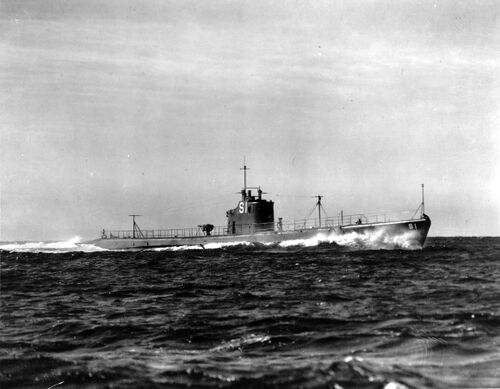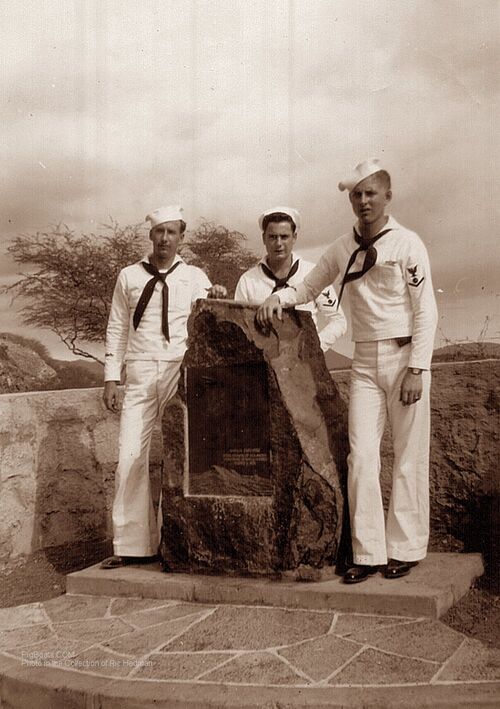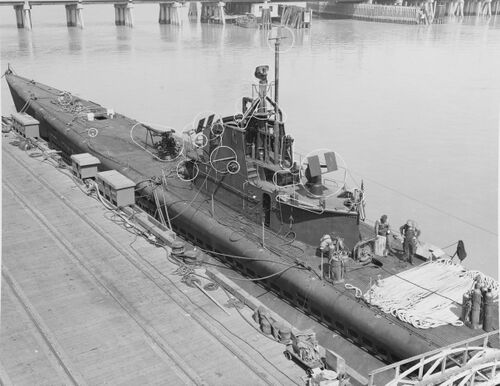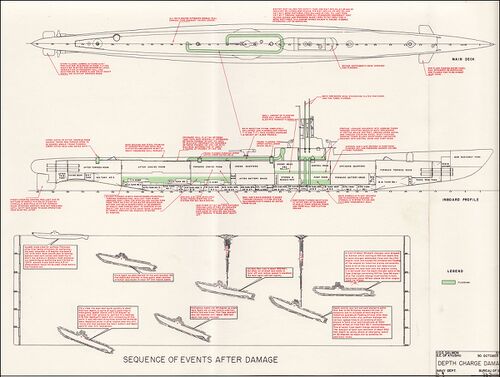182: Difference between revisions
(Created page with "Category:Fleet Submarines === File:Header 4 New.jpg=== File:Red bar sub new.jpg === '''USS Salmon SS 182''' ===") |
Pbcjohnston (talk | contribs) (Changed battle damage info) |
||
| (11 intermediate revisions by 2 users not shown) | |||
| Line 1: | Line 1: | ||
[[ | [[File:Header 4 New.jpg]] | ||
[[File:Salmon high speed stbd side NH 69872.jpg|left|500px]] | |||
<div style="text-align: justify;"><span style="color:#00008B">Salmon is shown running builder's trials in the Atlantic off Block Island early 1938. She is likely running a speed trial at this point, as she is throwing up a considerable bow wave. She would successfully pass the trials and be commissioned into the USN on March 15, 1938. | |||
<small>Photo NH 69872 courtesy of NHHC.</small> | |||
[[File:Red bar sub new.jpg]] | |||
[[File:Salmon francis h beaumont tm2-1.jpg|left|500px]] | |||
Navy portrait of Torpedoman 2nd Class Francis H. Beaumont of the USS Salmon (SS-182). Beaumont had previously served on the [[178|'''Permit (SS-178)''']] before transferring to Salmon. The breast badge on his uniform is the Submarine Combat Insignia. It is awarded to an individual who participated in a patrol in which an enemy ship was sunk. Gold stars are mounted on the scroll to indicate each successful patrol subsequent to that for which the original insignia was awarded. Stars may also be placed on the wave area of the insignia. A silver star indicates five successful patrols. Beaumont's Silver Dolphins insignia of a Qualified Submariner is embroidered on his right sleeve. The Dolphins insignia would not become a breast badge until 1950. | |||
[[File:Submarine_Combat_Patrol_Insignia.png|center|500px]] | |||
<small>Photo in the private collection of Ric Hedman.</small> | |||
[[File:Red bar sub new.jpg]] | |||
[[File:Salmon crew earhart memorial 8-43.jpg|left|500px]] | |||
Three members of the Salmon crew visiting the Amelia Earhart Memorial on Diamond Head, Oahu, August 1943. The men are listed on the back of the photo as "Enwood", "Stevens" and "Burgdorff" but no indication of which man is which. Spellings are approximate due to the nearly unreadable handwriting on photo back. | |||
<small>Photo in the private collection of Ric Hedman.</small> | |||
[[File:Red bar sub new.jpg]] | |||
[[File:Salmon 1943 amidships 19-N-42439.jpg|left|500px]] | |||
Salmon finishing up her first major wartime overhaul at Mare Island in March 1943. Her fairwater has been heavily modified to include cutting down both the forward and after ends of the fairwater to lessen her silhouette, and the addition of 20 mm guns on the new gun decks. The 20 mm guns have rectangular gun shields in place, but most boat's quickly removed them as being unnecessary and in the way. SJ radar has been added on the starboard side of the periscope shears, and SD radar on an extendable mast aft of the shears. Her 3"/50 caliber deck gun has been moved to the forward position. | |||
<small>Photo 19-N-42439 courtesy of NARA and NHHC.</small> | |||
[[File:Red bar sub new.jpg]] | |||
[[File:Salmon 1943 port side 19-N-42433.jpg|left|500px]] | |||
Salmon underway in San Pablo Bay north of San Francisco, March 22, 1943 at the conclusion of her overhaul at Mare Island. This photo gives a good overview of all of the changes made to this boat. These changes were typical of all of the Salmon/Sargo-class boats | |||
<small>Photo 19-N-42433 courtesy of NARA and NHHC.</small> | |||
[[File:Red bar sub new.jpg]] | |||
[[File:Salmon 1944 port amidships NH 97463.jpg|left|500px]] | |||
This photo of Salmon dates from August 16, 1944 and shows her near the end of her 2nd overhaul and modernization at Mare Island. She has received a whole new conning tower, fairwater, and periscope shears, making her resemble the much newer Balao-class submarines. She has also received two forty-foot periscopes in addition to numerous other upgrades. One of those upgrades was the installation of removeable blanking plates on all of the access hatches to the main deck. Those watertight blanking plates would prove to be a major factor in her survival from a massive depth charge attack later that year (see below). | |||
<small>Photo NH 97463 courtesy of NHHC.</small> | |||
[[File:Red bar sub new.jpg]] | |||
[[File:Salmon 1944 stbd NH 97462.jpg|left|500px]] | |||
A broad starboard side view of Salmon on San Pablo Bay off the Mare Island Navy Yard following her August 1944 overhaul and modernization. She bears little resemblance to her original configuration of 1938. | |||
<small>Photo NH 97462 courtesy of NHHC.</small> | |||
[[File:Red bar sub new.jpg]] | |||
[[File:Salmon Battle Damage- US Navy Report.jpg|left|500px]] | |||
On the night of October 30, 1944 Salmon engaged a small convoy consisting of a large tanker and four escorts southeast of Kyushu. Salmon got in two solid hits on the tanker, but was devastated by a very accurate depth charge counterattack by one of the escorts. Terribly damaged, Salmon had great difficulty in maintaining depth and at one point exceeded 500 feet. Barely regaining some level of depth control, the crew saw no other choice than to surface the nearly flooded boat and engage the escorts in a gun battle. She did so, and her tenacious and gutsy attack was so successful that it drove off one attacker and confused the others long enough for her to escape into a rain squall. Her damage was extensive, and this excerpt from her battle damage report highlights the range of her damage. She came under the escort of three other submarines and managed to make it back to the advanced base at Saipan. She was temporarily patched up and sent back to San Francisco via Pearl Harbor for further work, and eventually on to the Portsmouth Navy Yard in Maine. She had suffered some of the worst damage ever inflicted on a U.S. submarine that survived. She was found to be so badly damaged that returning her to full service was not feasible or warranted with the war obviously winding down. She spent the rest of the war as a partially mobile training vessel on the east coast. She was scrapped in 1946. Salmon and her crew were awarded a Presidential Unit Citation for extraordinary heroism in action against the enemy. Well earned shipmates. | |||
Please see the DANFS entry for Salmon [https://www.history.navy.mil/research/histories/ship-histories/danfs/s/salmon-ii.html '''at this link'''], and the [http://www.ibiblio.org/hyperwar/USN/rep/WDR/WDR58/WDR58-7.html '''full damage assessment report here''']. Note that there is some conflicting information in the two documents concerning Salmon's role after her return to the states and the dates of her decommissioning. | |||
<small>US Navy Battle Damage Report Image</small> | |||
[[File:Red bar sub new.jpg]] | [[File:Red bar sub new.jpg]] | ||
<center>[[Salmon/Sargo Class|Return to the Salmon/Sargo class page]] | [[Submarine Classes|Return to the Submarine Classes page]]</center> | |||
= | [[File:Red bar sub new.jpg]] | ||
<center> | |||
<span style="color:#00008B"> | |||
Page created by:<br> | |||
<small>Ric Hedman & David Johnston<br> | |||
1999 - 2023 - PigBoats.COM<sup>©</sup><br> | |||
Mountlake Terrace, WA, Norfolk, VA<br> | |||
webmaster at pigboats dot com</small> | |||
</center> | |||
[[File:Subs bottom line 2.jpg]] | |||
Latest revision as of 19:56, 15 November 2023

Photo NH 69872 courtesy of NHHC.

Navy portrait of Torpedoman 2nd Class Francis H. Beaumont of the USS Salmon (SS-182). Beaumont had previously served on the Permit (SS-178) before transferring to Salmon. The breast badge on his uniform is the Submarine Combat Insignia. It is awarded to an individual who participated in a patrol in which an enemy ship was sunk. Gold stars are mounted on the scroll to indicate each successful patrol subsequent to that for which the original insignia was awarded. Stars may also be placed on the wave area of the insignia. A silver star indicates five successful patrols. Beaumont's Silver Dolphins insignia of a Qualified Submariner is embroidered on his right sleeve. The Dolphins insignia would not become a breast badge until 1950.

Photo in the private collection of Ric Hedman.

Three members of the Salmon crew visiting the Amelia Earhart Memorial on Diamond Head, Oahu, August 1943. The men are listed on the back of the photo as "Enwood", "Stevens" and "Burgdorff" but no indication of which man is which. Spellings are approximate due to the nearly unreadable handwriting on photo back.
Photo in the private collection of Ric Hedman.

Salmon finishing up her first major wartime overhaul at Mare Island in March 1943. Her fairwater has been heavily modified to include cutting down both the forward and after ends of the fairwater to lessen her silhouette, and the addition of 20 mm guns on the new gun decks. The 20 mm guns have rectangular gun shields in place, but most boat's quickly removed them as being unnecessary and in the way. SJ radar has been added on the starboard side of the periscope shears, and SD radar on an extendable mast aft of the shears. Her 3"/50 caliber deck gun has been moved to the forward position.
Photo 19-N-42439 courtesy of NARA and NHHC.

Salmon underway in San Pablo Bay north of San Francisco, March 22, 1943 at the conclusion of her overhaul at Mare Island. This photo gives a good overview of all of the changes made to this boat. These changes were typical of all of the Salmon/Sargo-class boats
Photo 19-N-42433 courtesy of NARA and NHHC.

This photo of Salmon dates from August 16, 1944 and shows her near the end of her 2nd overhaul and modernization at Mare Island. She has received a whole new conning tower, fairwater, and periscope shears, making her resemble the much newer Balao-class submarines. She has also received two forty-foot periscopes in addition to numerous other upgrades. One of those upgrades was the installation of removeable blanking plates on all of the access hatches to the main deck. Those watertight blanking plates would prove to be a major factor in her survival from a massive depth charge attack later that year (see below).
Photo NH 97463 courtesy of NHHC.

A broad starboard side view of Salmon on San Pablo Bay off the Mare Island Navy Yard following her August 1944 overhaul and modernization. She bears little resemblance to her original configuration of 1938.
Photo NH 97462 courtesy of NHHC.

On the night of October 30, 1944 Salmon engaged a small convoy consisting of a large tanker and four escorts southeast of Kyushu. Salmon got in two solid hits on the tanker, but was devastated by a very accurate depth charge counterattack by one of the escorts. Terribly damaged, Salmon had great difficulty in maintaining depth and at one point exceeded 500 feet. Barely regaining some level of depth control, the crew saw no other choice than to surface the nearly flooded boat and engage the escorts in a gun battle. She did so, and her tenacious and gutsy attack was so successful that it drove off one attacker and confused the others long enough for her to escape into a rain squall. Her damage was extensive, and this excerpt from her battle damage report highlights the range of her damage. She came under the escort of three other submarines and managed to make it back to the advanced base at Saipan. She was temporarily patched up and sent back to San Francisco via Pearl Harbor for further work, and eventually on to the Portsmouth Navy Yard in Maine. She had suffered some of the worst damage ever inflicted on a U.S. submarine that survived. She was found to be so badly damaged that returning her to full service was not feasible or warranted with the war obviously winding down. She spent the rest of the war as a partially mobile training vessel on the east coast. She was scrapped in 1946. Salmon and her crew were awarded a Presidential Unit Citation for extraordinary heroism in action against the enemy. Well earned shipmates.
Please see the DANFS entry for Salmon at this link, and the full damage assessment report here. Note that there is some conflicting information in the two documents concerning Salmon's role after her return to the states and the dates of her decommissioning.
US Navy Battle Damage Report Image
Page created by:
Ric Hedman & David Johnston
1999 - 2023 - PigBoats.COM©
Mountlake Terrace, WA, Norfolk, VA
webmaster at pigboats dot com
